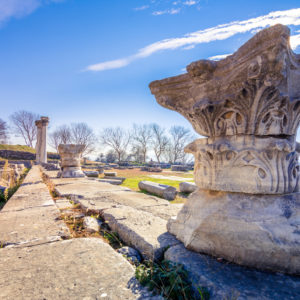Perama cave
Located five kilometers north of the center of Ioannina, in the northern part of Lake Pamvotida, is the village of Perama.
On the hill of Goritsa, intersecting the area, a crucial discovery was made in the 1940s. It happened unexpectedly when locals sought refuge from bombings and shelling during World War II. Several local boys, hiding from Italian air raids, accidentally discovered a cave and began using it as a bomb shelter.
The first description and exploration of the cave were carried out by renowned Greek speleologists Ioannis Petrohilos and Anna Petrohilou in 1954.
The total area of the Perama Cave is 14,800 square meters, and it took nature or a higher power—use the definition that resonates with you—over 1.5 million years for this geological marvel to acquire its modern form.
The general tourist route through the cave takes approximately 45 minutes, covering a distance of 1,100 meters. The cave features 19 large and small “halls,” the beauty of which leaves visitors in awe.
The first hall is named after Hades and Persephone, the rulers of the underworld in Greek mythology.
In the largest halls of the cave, No. 2 and 3, known as the “Great Palaces Halls,” the abundance of stalagmitic “statues” created by time and the constant movement of water in the cave is breathtaking. One of the most striking and impressive formations is a cross-shaped stalactite in the first hall, effectively transforming it into a unique, natural “temple.”
Trees budding, fountains, melted candles, the Egyptian sphinx, the Leaning Tower of Pisa, the Nativity scenes, the Three Wise Men, the Statue of Liberty, and many other shapes and names can be found in the cave. They reflect the vivid imagination of Ioannis and Anna Petrohilos in naming the stalactites, stalagmites, and stalacton columns they discovered.
The constant temperature in the cave is 18°C, while the temperature at the bottom of small lakes scattered throughout the cave is 14°C.
Currently, seven species of living organisms inhabit the cave, mainly various spider species. However, the remains of a cave bear discovered by speleologists indicate that the animal life in the cave was once much more diverse.






